Ostrava
| Ostrava | |||
| City | |||
 |
|||
|
|||
| Country | Czech Republic | ||
|---|---|---|---|
| Region | Moravian-Silesian | ||
| Little District | Ostrava | ||
| Parts |
23
|
||
| Center | Masarykovo náměstí | ||
| - elevation | 260 m (853 ft) | ||
| - coordinates | |||
| Area | 214 km² (83 sq mi) | ||
| - metro | 3,896 km² (1,504 sq mi) | ||
| Population | 336,909 (March 31, 2008) | ||
| - metro | 1,164,328 [1] | ||
| Density | 1,589.2 /km² (4,116 /sq mi) | ||
| Founded | 1267 | ||
| Mayor | Petr Kajnar (ČSSD) | ||
| Postal code | 702 00 | ||
  Location in the Czech Republic
|
|||
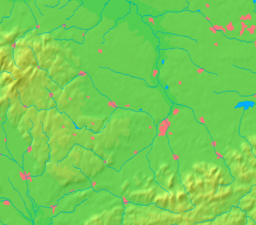  Location in the Moravian-Silesian Region
|
|||
| Website: www.ostrava.cz | |||
Ostrava (pronounced [ˈostrava], German: Ostrau, Polish: Ostrawa) is the third largest city in the Czech Republic, however it is the second largest urban agglomeration after Prague. It is also the administrative center of the Moravian-Silesian Region and of the Municipality with Extended Competence. Ostrava is located at the confluence of the Ostravice, Oder, Lučina and Opava rivers. Its history and growth have been largely affected by exploitation and further usage of the high quality black coal deposits discovered in the locality, giving the town a look of an industrial city and a nickname of the “steel heart of the republic” (Czech: ocelové srdce republiky) during the communist era of Czechoslovakia. Many of the heavy industry companies are being closed down or transformed nowadays.
Contents |
History
Ostrava was an important crossroads of prehistoric trading routes, namely the Amber Road. Archaeological finds have proved that the area around Ostrava has been permanently inhabited for 25,000 years. The town itself was founded in 1267. Until the late 18th century, Ostrava was a small provincial town with a population around one thousand inhabitants engaged in handicraft.
In 1763, large deposits of black coal were discovered, leading to an industrial boom and a flood of new immigrants in the following centuries. During the 19th century, several mine towers were raised in and around the city and the first steel works were established. Industrial growth was made possible by the completion of Kaiser-Ferdinands-Nordbahn from Vienna in 1847. The 20th century saw further industrial expansion of the city accompanied by an increase in population and the quality of civic services and culture. However, during World War II, Ostrava - as an important source of steel for the army industry - suffered several massive bombing campaigns bringing large amounts of damage to the city.
Since the Velvet revolution in 1989 the city is going through big changes. A thorough restructuring of industry is taking place - coal mining in the area of the city was stopped in 1994 and a large part of the Vítkovice ironworks near the city center was closed down in 1998, both improving the environment dramatically, although the Arcelor Mittal plant (ex-Nová Huť) continues to heavily pollute the Radvanice district and surrounding area, resulting in one of the highest concentrations of PM10 dust in Europe.[2]
Mayors
| Period | Name |
|---|---|
| 1861–1864 | Hermann Zwierzina |
| 1864–1873 | Alois Anderka |
| 1873–1880 | Konstantin Grünwald |
| 1880–1888 | Anton Lux |
| 1888–1901 | Adalbert Johanny |
| 1901–1918 | Gustav Fiedler |
| 1918 | Johann Ulrich (until 17th December 1918) |
| 1918–1935 | Jan Prokeš |
| 1935–1939 | Josef Chalupník |
| 1939–1940 | Josef Hinner |
| 1940–1945 | SS Sturmbannführer Emil Beier |
| 1945 | Josef Lampa (interim, for three weeks) |
| 1945–1960 | Josef Kotas |
| 1960–1964 | Jan Buchvaldek |
| 1964–1968 | Josef Kempný |
| 1968–1971 | Zdeněk Kupka |
| 1971–1986 | Eduard Foltýn |
| 1986–1989 | Bedřich Lipina |
| 1989–1990 | Lubomír Vejr |
| 1990–1993 | Jiří Smejkal |
| 1993–2001 | Evžen Tošenovský |
| 2001–2002 | Čestmír Vlček |
| 2002–2006 | Aleš Zedník |
| 2006– | Petr Kajnar |
Geography and climate
| for Ostrava | |||||||||||||||||||||||||||||||||||||||||||||||
|---|---|---|---|---|---|---|---|---|---|---|---|---|---|---|---|---|---|---|---|---|---|---|---|---|---|---|---|---|---|---|---|---|---|---|---|---|---|---|---|---|---|---|---|---|---|---|---|
| J | F | M | A | M | J | J | A | S | O | N | D | ||||||||||||||||||||||||||||||||||||
|
38
2
-3
|
43
4
-2
|
40
9
3
|
50
14
5
|
61
19
9
|
73
22
13
|
63
25
15
|
58
25
15
|
45
21
12
|
40
14
6
|
50
7
2
|
43
4
-1
|
||||||||||||||||||||||||||||||||||||
| temperatures in °C precipitation totals in mm source: weather.com[3] |
|||||||||||||||||||||||||||||||||||||||||||||||
|
Imperial conversion
|
|||||||||||||||||||||||||||||||||||||||||||||||
Ostrava is located in the north-eastern tip of the Czech Republic, very close to the Polish (15km) and Slovak (55km) borders. It spreads over the northern part of the natural north-south valley called the Moravian Gate (Moravská brána) with the average elevation of around 210m above sea level.
The local climate is temperate with hot summers and mild, humid winters. The yearly average temperature is 10.2°C (January: -1.2°, July: 19.8°), the yearly rainfall is around 600mm.
People and demographics
As of March 2008, the officially estimated population of Ostrava is 336,909 inhabitants, who are living in a total of 23 districts formed by joining together 34 original small towns and villages. Ostrava covers an area of 212 km². The population density is 1589 people per km².
Historically, among the most influencial ethnic groups besides Czechs in Ostrava were the Poles, Germans and the Jews. However, during and after the World War II years the situation changed completely, as most Ostravian Jews were killed or transported to concentration camps (on October 17, 1939 the first transport of Jews to a lager in Nisko, General Government was held in Ostrava - the first of its kind in Europe). After World War II, Germans were expelled from Ostrava according to the Potsdam Agreement. Thus, the population of the city, has become a mixture of Silesians, Moravians, Czechs, Slovaks and Poles.
Due to the recent and ongoing massive restructuring of the heavy industry in the area, the unemployment rate went well above the country average - 8.7 % (as of March 2008).
Industry and coal mines
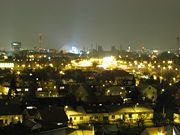
Some of the largest Czech industrial companies lie in the city of Ostrava. The Vítkovice steel works, located in the suburb of the same name near the city center, concentrates on metallurgy and machine engineering. It was established in 1828 and nowadays, after nearly two hundred years of existence, it is undergoing a major transformation. The oldest part of the concern, called "Dolní oblast" (the "Bottom area"), was closed down and there is an ongoing debate whether this area should be preserved and opened up as an industrial open-air museum or torn down. Nová huť (the "New Steel Works", established in 1951), now belongs to the international concern Mittal Steel, is another key metallurgical combine in Ostrava.
Contrary to the popular belief among Czechs, Ostrava is not a mining town anymore - all its mines have been closed down a short time after the Velvet revolution, due to unfavourable geological and political conditions which caused the mining to become uneconomic in the post-communist system, and also in ex-mayor Evžen Tošenovský's drive to modernize the city's industries. The last mine car with coal was retrieved from the mine Odra on the Oder river on June 30, 1994.
Karolina
Karolina is approximately 30 hectares large area situated 500m from City's historic square. The Karolina Area was originally used for heavy industry. After demolition of old coking plant and clearing all area, the Karolina area can now be used for an extension of Ostrava city centre.
In late June 2006 Dutch firm Multi Development has won the tender for the development of the grounds of the former Karolina. Company will thus be invited to sign the contract, which must be done within three months. Multi Development plans to invest 13 billion CZK (EUR 450 million).
In this new city district should be many new apartments, offices and shops. There should be also a new church, high-rise building, large park by the Ostravice River and campus university.
Culture
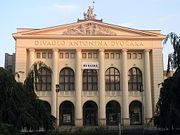
There are four theatres in Ostrava: Moravian-Silesian National Theatre (Národní divadlo moravskoslezské). It has two buildings: Divadlo Antonína Dvořáka (named after Antonín Dvořák) and Divadlo Jiřího Myrona. Further there are Petr Bezruč Theatre (named after Petr Bezruč), Komorní scéna Aréna (Chamber theatre Arena) and Divadlo loutek (Puppet theatre).
Universities
- VŠB – Technical University of Ostrava – Official web
- University of Ostrava – Official web
- Business School Ostrava plc – Official web
Main sights
While Ostrava is usually not in the top ten list of tourist attractions of the Czech Republic, there are a number of interesting places to see and things to do there. To the north of the city center there is the Museum of Mining (Hornické muzeum) presenting a unique collection of the coal mining machinery and equipment, a reconstruction of a mammoth hunters' settlement. Going down the shaft to see the 250m long underground corridors and an original mining gallery from the 19th century is also part of the exhibition.
Just to the north and running west of the Museum of Mining is a fortification system known as the "Beneš Wall", a line of garrison fortifications similar to the Maginot Line. The hurried construction of the line of defenses was of great concern to the German military, and after it was annex was used as testing and training for the attacks against the western fort complexes. The fort "MO-19 "Alej" next to the town of Darkovicky is mostly restored and open to the public, however the boarder region is dotted with an endless line of abandoned pillboxes and forts.
Another attraction, which is becoming more and more popular mainly among young people, is Stodolní Street (Stodolní ulice), actually a bunch of streets just next to the center, full of bars, pubs and clubs, bringing night-life to the city and thousands of visitors all year long. There are currently around 60 places to have a drink or dance on this street, each of its own style and atmosphere. There are a few bigger events at this street throughout the year, the largest of which is the Colours of Ostrava - a summer music festival hosting many musicians and groups from all over the world.
The New city hall viewing tower provides visitors a panoramic view of the city and surroundings from about 72 meters of height. During clear sky conditions the Moravian-Silesian Beskids and Jeseníky mountain ranges are visible.
The Silesian Ostrava Castle is one of the city's most historic cultural monuments. The castle was built in the eighties and nineties of the 13th century. In 1534, the gothic castle was rebuilt into a renaissance chateau. It was restored recently after many years of dilapidation, caused by coal mining under the castle. Today, the castle is one of the most important tourist attraction of the city. It hosted the Colours of Ostrava 2007 music festival.
You can visit a zoological garden located in Stromovka park in Slezská Ostrava. On May 1 1960 it was opened to the public, although incomplete.
Sport in Ostrava
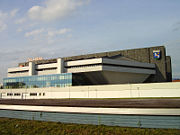
Football (soccer) teams:
- FC Baník Ostrava
- FC Vítkovice
Ice-hockey teams:
- HC Vítkovice
Athletics:
- Golden Spike
Other information
Ostrava is a sister city with these foreign towns and cities (the year the cooperation started is given in the parentheses and determines the ordering):
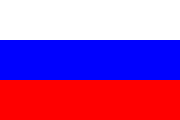 - Volgograd, Russia (1947)
- Volgograd, Russia (1947) - Coventry, United Kingdom (1957)
- Coventry, United Kingdom (1957) - Katowice, Poland (1960)
- Katowice, Poland (1960) - Dresden, Germany (1971)
- Dresden, Germany (1971) - Split, Croatia (1976)
- Split, Croatia (1976) - Pireus, Greece (1997)
- Pireus, Greece (1997) - Košice, Slovakia (2001)
- Košice, Slovakia (2001) - Miskolc, Hungary (2001)
- Miskolc, Hungary (2001) - Pittsburgh, Pennsylvania, USA (2001)
- Pittsburgh, Pennsylvania, USA (2001) - powiat wodzisławski, Poland (2005)
- powiat wodzisławski, Poland (2005)
People
- Kateřina Baďurová
- Věra Chytilová
- Ota Filip
- Marek Jankulovski
- Petr Kalus
- Filip Kuba
- Ivan Lendl
- Artur London
- Marek Malík
- Luděk Mikloško
- Jaromír Nohavica
- Richard Šmehlík
- Dieter F. Uchtdorf
- Vladimír Vůjtek
Notes
- ↑ Larger urban zone, Eurostat 2003
- ↑ "Ostravsko už ví, proč má špatný vzduch. Špiní jej hutě" (2008). Retrieved on 2008-07-04.
- ↑ "Monthly Averages for Ostrava, Czech Republic" (in English). Retrieved on 2008-02-28.
External links
- Ostrava travel guide from Wikitravel
- City information centre
- Ostrava information server
- Ostrava's companies
- Ostrava Newspaper
- Ostrava community website
- City information center
- Zoo Ostrava official website
- Ostrava Weather Forecast
- Ostrava in photo
- Ostrava – City in Motion (official promotional video)
|
|||||
|
||||||||||||||
|
|||||||


